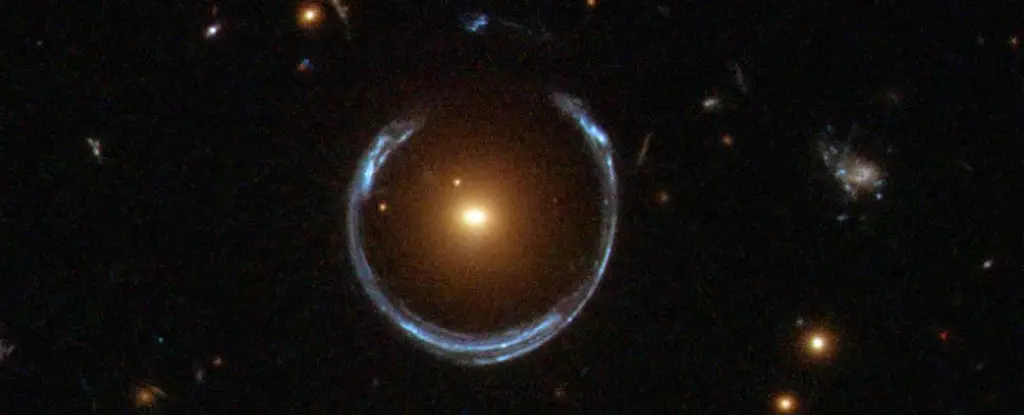The fascination with black holes has captivated astronomers and enthusiasts alike for decades. Among the most intriguing discoveries in this domain is the Cosmic Horseshoe, a remarkable gravitational lensing phenomenon fostered by a colossal black hole at its center. This article delves into the significance of this lensing effect and its implications for our understanding of the universe, particularly focusing on Ultra-Massive Black Holes (UMBHs) and their role in cosmic evolution.
In 2007, astronomers unveiled the Cosmic Horseshoe, a fascinating cosmic structure located approximately 5.5 billion light-years from Earth. This gravitationally lensed system consists of a foreground galaxy that serves as a lens, distorting and amplifying the light from a more distant background galaxy. The precision of this alignment produces a striking visual effect known as an Einstein Ring, named after the physicist who first predicted this phenomenon.
Recent studies have expanded our comprehension of this remarkable system. A groundbreaking paper titled “Unveiling a 36 Billion Solar Mass Black Hole at the Centre of the Cosmic Horseshoe Gravitational Lens,” authored by Carlos Melo-Carneiro from Brazil, revealed the presence of an extraordinary Ultra-Massive Black Hole (UMBH) nestled within the foreground galaxy. With a mass estimated at a staggering 36 billion solar masses, this discovery raises questions about the formation and evolution of such dominant celestial entities.
The term Ultra-Massive Black Hole typically describes a supermassive black hole that exceeds an impressive threshold of 5 billion solar masses. While there is no universally accepted benchmark for classifying these supermassive giants, the prominence of UMBHs in astronomical observations warrants a distinctive designation. The discoveries leading to the establishment of this category arrived gradually rather than through traditional methods of discovery; over time, the astronomical community has recognized the existence of these massive black holes as we have advanced in our observational capabilities.
The Cosmic Horseshoe’s UMBH exemplifies a specific challenge within the context of the MBH-sigmae relation—a correlation between a black hole’s mass and the velocity dispersion of stars within its host galaxy. This relationship is crucial to understanding how black holes influence their galactic environments and how galaxy evolution plays a role in black hole growth.
LRG 3-757, the foreground galaxy in the Cosmic Horseshoe, is classified as a Luminous Red Galaxy (LRG)— a rare type that is especially luminous in infrared light. With a mass around 100 times that of our Milky Way, LRG 3-757 ranks among the most massive galaxies known to date. The remarkable finding of a 36 billion solar mass black hole at its center solidifies the connection between a galaxy’s mass and that of its associated black hole.
Research indicates that supermassive black holes are prevalent in massive galaxies, establishing a profound connection between the properties of the host galaxies and their central black holes. Despite the established MBH-sigmae relation, the UMBH chief of LRG 3-757 exhibits a notable deviation from this well-understood correlation, thereby challenging existing paradigms regarding galaxy and black hole co-evolution.
The peculiar relationship observed with the UMBH in the Cosmic Horseshoe has led researchers to speculate on the reasons behind this deviation from the expected patterns. One of the principal hypotheses revolves around the idea that interactions of massive galaxies could have an impact on stellar dynamics, potentially resulting in what is known as “scouring.”
Scouring occurs during significant galactic mergers, where stellar velocity dispersions may be reduced as central stars are expelled from the vicinity of the black hole, even though the mass of the black hole remains relatively unchanged. Furthermore, theories posit that feedback loops from active galactic nuclei (AGN)—regions surrounding black holes where gas and dust fall into the black hole—could also disrupt the expected correlations by providing energetic outflows that inhibit star formation within the host galaxy.
The UMBH seated in the Cosmic Horseshoe may also be residual from the early universe’s luminous quasars, demonstrating a rapid growth period not typical of more commonly observed cases today. Such insights into the formation and evolution of UMBHs not only deepen our understanding of black holes but also shed light on overarching cosmic processes.
The study on the Cosmic Horseshoe is merely a stepping stone towards greater understanding. As astronomers continue to explore the universe, the imminent launch of missions like the Euclid space telescope promises to enhance our grasp of gravitational lensing and reveal countless other instances of such phenomena across the cosmos. This mission, along with the forthcoming Extremely Large Telescope (ELT), will facilitate high-resolution observations, thus refining our understanding of both black holes and the galaxies that harbor them.
In closing, as we venture into this new era of discovery, it is imperative to acknowledge the contributions of findings like the Cosmic Horseshoe in elucidating the complexities of galaxy evolution and the intricate relationships between celestial giants. This journey is far from over; the more we learn, the more questions emerge, propelling us to further investigate the cosmos that so profoundly shapes our understanding of reality.


Leave a Reply